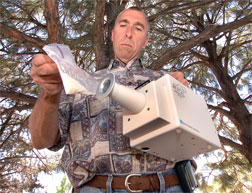NEWS RELEASES
FOR IMMEDIATE RELEASE
March 2, 2005
Texas police, border agents using Labs’ sniffer to nab drug traffickers
Drug task force credits Hound system with helping save lives
 Sandia National Laboratories researcher Dave Hannum demonstrates use of the Hound system on a bag of white powder. (Photo by Randy Montoya) Download 300dpi JPEG image, ‘hannum-hound.jpg’, 1.6MB (Media are welcome to download/publish this image with related news stories.)
Sandia National Laboratories researcher Dave Hannum demonstrates use of the Hound system on a bag of white powder. (Photo by Randy Montoya) Download 300dpi JPEG image, ‘hannum-hound.jpg’, 1.6MB (Media are welcome to download/publish this image with related news stories.) ALBUQUERQUE, N.M. — On a South Texas highway local police and border agents are using a hand-held sniffer developed at Sandia National Laboratories to help stem the flow of illegal drugs northward into the U.S.
Sandia loaned the South Texas Specialized Crimes and Narcotics Task Force one of its prototype Hound systems in November 2003 as part of a field trial to evaluate the system for drug detection. Since then Task Force officers have used the Hound system at border checkpoints to help screen vehicles for narcotics and drug money.
Task Force officials say its officers have on numerous occasions used the Hound system to help local, state, and federal law enforcement officers detect covert narcotics shipments in vehicles at checkpoints; locate nitro, heroin, cocaine, and marijuana in middle schools and high schools; seize drug money going south into Mexico; and build a case against a suspect in a night club shooting.
In a few cases the officers credit the device with saving lives.
“There are not enough good things I can say about this tool,” says Task Force Commander Jaime Garza.
The field trials are made possible through funding from the U.S. Department of Justice’s National Institute of Justice and its National Law Enforcement and Corrections Technology Center (NLECTC).
Sandia is a National Nuclear Security Administration laboratory.
Drugs in fingerprints
The toolbox-sized Hound system includes a front-end sniffer developed by Sandia for sample collection and a commercial chemical detector that works for both explosives and drugs.
Although the system was originally developed for explosives, the switch from detection of explosives to drugs is relatively simple within the commercial detector, says Dave Hannum, one of the Sandia developers of the preconcentration technique that makes the Hound system so sensitive.
The sniffer works by drawing a bathtub’s worth of air through its nozzle, trapping heavy organic compounds in the air on a filter, then heating the filter and redistributing the collected compounds into a smaller air sample. The compounds then are identified in a commercial ion mobility spectrometer-based detector that is part of the system.
It’s the equivalent of netting hundreds of fish in a vast ocean, then releasing those fish into a pond and fishing for them, with much increased odds.
The Hound system is sensitive enough to detect and identify residues in the fingerprints drug users leave behind on door handles, steering wheels, locker latches, etc.
Sandia pioneered the preconcentration approach in the mid 1990s and has since developed a family of explosives-detection systems based on the technique, including hand-held detectors, a vehicle screening system, and a walk-through portal that can sniff trace amounts of explosives on people’s skin and clothing.
A commercial version of the portal is now being used to screen airline passengers at a checkpoint at New York’s JFK airport as part of a Transportation Security Administration pilot project. (See http://www.sandia.gov/LabNews/LN12-10-04/key12-10-04_stories.html#portal.)
Helping officers
During the field trials in South Texas, the Task Force has used the Hound system as part of border checkpoint screening procedures, using both drug-trained dogs and the Sandia sniffers to canvass a selection of vehicles that were diverted by officers into a secondary screening area, says Garza.
Task Force officers also respond to requests from the local sheriff’s department and U.S. Border Patrol agents to investigate suspicious vehicles and items, he says.
Although the Hound alone won’t solve the drug problem, says Hannum, the Task Force has documented situations this past year where the use of the Hound has helped.
In one case the Hound system quickly identified a mysterious substance found in an under-seat compartment as liquid meth — a highly flammable and toxic substance that could have been a health threat to officers. In another case, the discovery of cocaine on a young man’s driver’s license led to an admission of his addiction and his entry into a drug rehab program.
“It was truly an eye-opening experience to learn about the magnitude of the drug problem that is happening every day along the border,” says Hannum. “One Hound system cannot even put a dent in that drug pipeline. However, it is a tool that can clearly help officers detect and correctly identify certain illegal substances that they have to deal with on a daily basis.”
He says the information gathered during the trials is being used to improve the Hound system for drug detection applications. Commercialization efforts are underway.
“I am proud and grateful to be in a position to help,” adds Hannum.
Sandia is a multiprogram laboratory operated by Sandia Corporation, a Lockheed Martin company, for the U.S. Department of Energy"s National Nuclear Security Administration. Sandia has major R& D responsibilities in national security, energy and environmental technologies, and economic competitiveness.
Sandia media contact: Michael Padilla, mjpadil@sandia.gov, (505) 284-5325